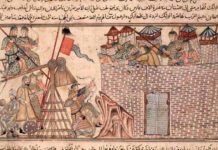
The manuscript of the rollicking adventure story the Hamzanama was the first major artwork to emerge from the studio of the Mughal Emperor Akbar.
The Hamzanama (Story of Hamza) was a popular series of tales loosely based on the life of the uncle of the Prophet Muhammad. Dating back to the eleventh century, the stories, with their heroes and villains, cunning ruses, giants and fantastical creatures, were a staple of the Persian oral tradition, and a favourite of the young Emperor Akbar.
Emperor Akbar and the Hamzanama
Akbar was just 13 years old when he became the third Mughal Emperor of India in 1556. Energetic, daring and often impetuous, he wasn’t the type of child to sit still for long for formal lessons. He did however have a passion for knowledge and culture, and would grow up to be a discerning patron of art. In this he was no doubt helped by the presence at court of two Persian master artists, Mir Sayyid ‘Ali and Abdu al-Samad, who joined the entourage of Akbar’s father Humayun after Humayun took refuge at the Persian court in 1543-44. They would take charge of the production of the Hamzanama.
Given his youth and dynamic personality, the swashbuckling stories in the Hamzanama would appear to be a perfect fit for Akbar. The emperor was said to be so taken with them that he would often recite them in the harem. So it was that some time in the early 1560s he gave orders that the story of Hamza be written down and illustrated.
The Hamzanama
The Hamzanama was the first major manuscript commission undertaken by the imperial art studio of Akbar. As relatively little has survived (150 paintings now scattered in collections around the world) certain aspects of the manuscript remain mysterious, and the subject of lively scholarly debate. It is generally agreed however that the manuscript took 15 years to produce, and dates to early in Akbar’s reign, from 1562 to 1577.
The figures vary, but there’s no denying the Hamzanama was a huge project. It consisted of either 12 or 14 volumes, with 100 paintings per volume. 61 folios are now in the collection of the Museum fur Angewandte Kunst in Vienna, and 24 pages and 3 fragments in the Victoria and Albert Museum in London.
The pictures were painted on cotton backed with thin paper, and the text on the reverse of each folio is written on thicker, white paper backed with cotton. The paintings were poster size, and were possibly held up to illustrate a scene as it was being recited.
The paintings in Akbar’s Hamzanama are particularly important from an art historical point of view. They are the first major works to display the vibrant mix of Persian and Indian styles, both Muslim and Hindu, that have come to define the best of Mughal art. While there were a number of Persian painters in the imperial studio, many of the painters who worked there must have been Hindu, who were trained in very different traditions. The end result is a happy mix of the refinement of Persian painting and the bold vibrancy of Indian art.
Sources:
- Sheila Blair & Jonathan Bloom, The Art and Architecture of Islam 1250-1800 (Yale University Press, 1994)
- Abraham Eraly, The Mughal Throne (Weidenfeld and Nicholson, 2003)
- John Seyller, “A Dated Hamzanama Illustration”, Artibus Asiae, Vol. 53 (1993)
- Susan Stronge, Painting for the Mughal Emperor: The Art of the Book 1560-1660 (V&A Publications 2002)







